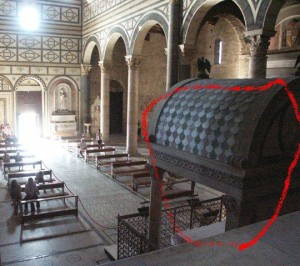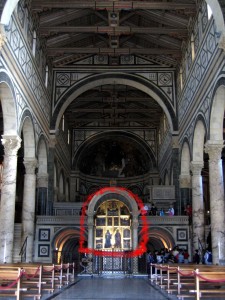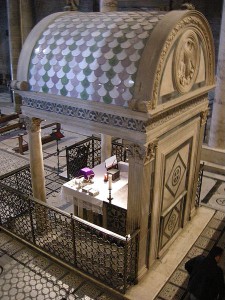San Miniato: Renaissance Vandalism September 28, 2010
Author: Beach Combing | in : Medieval , trackback Beachcombing has loved the extraordinary monastery of San Miniato (Florence), his favourite continental church, since he first saw it fifteen years ago. Started in a largely undocumented generation in the eleventh century it showed from the beginning an ambition that, though wholly medieval in form, anticipated the Florentine renaissance in terms of its self-confident eccentricity. However, there was, to Beachcombing’s mind, something that did not work with the church, something that was not quite right, the architectural equivalent of an eye-lash in the eye, irritating but unidentifiable.
Beachcombing has loved the extraordinary monastery of San Miniato (Florence), his favourite continental church, since he first saw it fifteen years ago. Started in a largely undocumented generation in the eleventh century it showed from the beginning an ambition that, though wholly medieval in form, anticipated the Florentine renaissance in terms of its self-confident eccentricity. However, there was, to Beachcombing’s mind, something that did not work with the church, something that was not quite right, the architectural equivalent of an eye-lash in the eye, irritating but unidentifiable.
Beachcombing always had a sense that this ‘eyelash’ had something to do with space and finally identified the problem on a trip to San Miniato this week while being shown around by a brilliant guide, an erudite monk of the foundation.
But before getting to the ‘eyelash’ a little about San Miniato’s use of space. Walking into the church you are immediately struck by an immense barrel of darkness lit only by small windows and the large church doors behind you.
Those doors are the church’s main source of light and one of Beachcombing’s students once commented in a trip in December that San Miniato was ‘creepy’. Certainly without the blue Italian skies coming through the doors the mood inside darkens. Don’t, whatever you do, visit on a rainy day.
 But beyond the light of the main doors something very strange happens. As you walk towards the apse the floor rises before you and the church effectively becomes split level. Half of the crypt is visible and the pulpit and original altar and the extraordinary golden mosaic of Christ, the virgin and Saint Minias are raised high above the congregation.
But beyond the light of the main doors something very strange happens. As you walk towards the apse the floor rises before you and the church effectively becomes split level. Half of the crypt is visible and the pulpit and original altar and the extraordinary golden mosaic of Christ, the virgin and Saint Minias are raised high above the congregation.
To have been seated at the back in the Middle Ages would have been a remarkable experience. The crypt would have been visible but inky dark, save for candles, with sung voices rising from out of the depths evoking at best death at worst hell. The apse, instead, would have glowed with the precious light of the golden mosaic but the priest would have only been visible while preaching. The altar itself would have been hidden from medieval eyes and the communion bread would have been broken out of sight in almost Orthodox fashion.
Beachcombing has placed everything back in the past here because in the fifteenth-century the medieval space in the church was broken by the insertion of Michelozzo’s altar into the centre of the church: rudely inked in red by Beachcombing on the photos. The hidden, mysterious Christ of medieval times became a communal shared Christ, anticipating the reformation and counter-reformation . This was Beachcombing’s ‘eyelash’ and the photos give some sense of just how it gets in the way.
. This was Beachcombing’s ‘eyelash’ and the photos give some sense of just how it gets in the way.
Beachcombing blogged only two days ago on a joke about blowing up an airport going terribly wrong and so chastened he is going to be very careful about what he says next. However, the medieval monk in Beachcombing would dearly love to ‘remove’ the ‘eyelash’ from San Miniato and see it, at least for a ten minutes, as it was seen by the faithful in the thirteenth century puffed up with incense and hope.
Beachcombing has no great love for the Italian Renaissance but he can think of no other example of Renaissance arrogance destroying ‘the symbolic language’ of the Middle Ages. Other instances would be welcome: drbeachcombing AT yahoo DOT com


